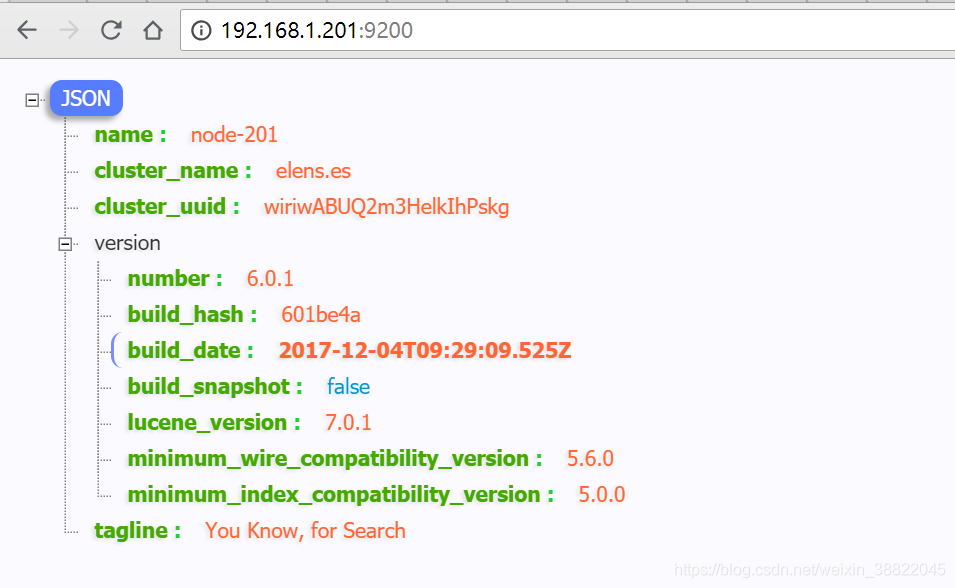ElasticSerach:安装前期工作
①:安装JDK-1.8(下载解压,配置profile,很简单就不赘述了),Centos 7.0
②:下载ElasticSerach安装包,自行选择版本(本人选择6.0.1),下载地址:https://www.elastic.co/downloads/past-releases
③:下载ElasticSerach的IK分词器安装包,下载地址:https://github.com/medcl/elasticsearch-analysis-ik/releases
提供 ElasticSearch6.0.1和kinbana-6.0.1和JDK1.8,和IK和拼音分词器
链接:https://pan.baidu.com/s/1bZWgP4oAZbCN-91-U3enwg
提取码:8e5e
正式安装:
第一步:上传下载的elasticsearch-6.0.1.tar
tar -zxvf elasticsearch-6.0.1.tar
第二步:修改配置文件:conf/elasticserach.xml【清空所有配置文件】
elasticSerach.xml
#集群名
cluster.name : elens.es
#节点名
node.name : node-201
#设置绑定的ip地址,可以是ipv4或ipv6的,默认为0.0.0.0,
#指绑定这台机器的任何一个ip
network.bind_host : 0.0.0.0
#设置其它节点和该节点交互的ip地址,如果不设置它会自动判断,
#值必须是个真实的ip地址
network.publish_host : 192.168.1.202
#设置对外服务的http端口,默认为9200
http.port : 9200
#设置节点之间交互的tcp端口,默认是9300
transport.tcp.port : 9300
#是否允许跨域REST请求
http.cors.enabled : true
#允许 REST 请求来自何处
http.cors.allow-origin : "*"
#节点角色设置
node.master : true
node.data : true
#有成为主节点资格的节点列表
discovery.zen.ping.unicast.hosts : ["192.168.1.201:9300", "192.168.1.202:9300", "192.168.1.203:9300","192.168.1.204:9300"]
#集群中一直正常运行的,有成为master节点资格的最少节点数(默认为1)
# (totalnumber of master-eligible nodes / 2 + 1)
discovery.zen.minimum_master_nodes : 2第三步:创建虚拟机非Root用户,es不支持root用户启动
username:test password:test
第四步:chmod -R 777 elasticsearch-6.0.1 [es解压的文件夹] 层级全部授权,防止没有权限执行失败!
第五步:ES启动报错
【1】: max file descriptors [65535] for elasticsearch process is too low, increase to at least [65536]
【2】: max number of threads [1024] for user [es] is too low, increase to at least [4096]
【3】: max virtual memory areas vm.max_map_count [65530] is too low, increase to at least [262144]
切换到root用户
1、vi /etc/security/limits.conf 修改如下配置
* soft nofile 65536
* hard nofile 131072
* soft nproc 2048
* hard nproc 4096
2、vi /etc/security/limits.d/90-nproc.conf 修改如下配置
* soft nproc 2048
3、vi /etc/sysctl.conf 添加配置
vm.max_map_count=655360
运行命令 sysctl -p
第六步:下载es对应版本的IK分词器
cd /elasticsearch-6.0.1/plugins
unzip elasticsearch-analysis-ik-6.0.1.zip
rm elasticsearch-analysis-ik-6.0.1.zip [删除压缩包]
第六步:启动es
[test@bigdata003 elasticsearch-6.0.1]# ./bin/elasticsearch -d
第七步:页面访问9200端口
IP:9200

Kinbana的安装
1、环境准备
Kibana是ElasticSearch的可视化平台,依赖ElasticSearch,需要优先安装ElasticSearch。
示例:ElasticSearch 6.0.1 集群
2.Kibana下载
Kibana官方下载地址:https://www.elastic.co/cn/downloads/kibana
根据ElasticSearch版本及安装环境下载相应的Kibana安装包。
示例:kibana-6.0.1-linux-x86_64.tar.gz
3.Kibana 安装及配置
将安装包上次到服务器,然后解压安装包,例如解压到:/mnt/
tar –zxvf kibana-6.0.1-linux-x86_64.tar.gz -C /mnt/
然后到kibana安装目录的config下,编辑kibana.yml配置文件,添加如下配置:
# Kibana is served by a back end server. This setting specifies the port to use.
server.port: 5601
# Specifies the address to which the Kibana server will bind. IP addresses and host names are both valid values.
# The default is 'localhost', which usually means remote machines will not be able to connect.
# To allow connections from remote users, set this parameter to a non-loopback address.
server.host: "192.168.1.215"
# Enables you to specify a path to mount Kibana at if you are running behind a proxy. This only affects
# the URLs generated by Kibana, your proxy is expected to remove the basePath value before forwarding requests
# to Kibana. This setting cannot end in a slash.
#server.basePath: ""
# The maximum payload size in bytes for incoming server requests.
#server.maxPayloadBytes: 1048576
# The Kibana server's name. This is used for display purposes.
#server.name: "your-hostname"
# The URL of the Elasticsearch instance to use for all your queries.
#此处填写的是ElastcSearch的主节点 ,注解点查看方法,192.168.1.212:9200/_cat/nodes
# 192.168.1.214 11 90 4 0.15 0.48 0.53 mdi * node-2 带星号的就是主节点
elasticsearch.url: "http://192.168.1.214:9200"
# When this setting's value is true Kibana uses the hostname specified in the server.host
# setting. When the value of this setting is false, Kibana uses the hostname of the host
# that connects to this Kibana instance.
#elasticsearch.preserveHost: true
# Kibana uses an index in Elasticsearch to store saved searches, visualizations and
# dashboards. Kibana creates a new index if the index doesn't already exist.
#kibana.index: ".kibana"
# The default application to load.
#kibana.defaultAppId: "discover"
# If your Elasticsearch is protected with basic authentication, these settings provide
# the username and password that the Kibana server uses to perform maintenance on the Kibana
# index at startup. Your Kibana users still need to authenticate with Elasticsearch, which
# is proxied through the Kibana server.
#elasticsearch.username: "user"
#elasticsearch.password: "pass"
# Enables SSL and paths to the PEM-format SSL certificate and SSL key files, respectively.
# These settings enable SSL for outgoing requests from the Kibana server to the browser.
#server.ssl.enabled: false
#server.ssl.certificate: /path/to/your/server.crt
#server.ssl.key: /path/to/your/server.key
# Optional settings that provide the paths to the PEM-format SSL certificate and key files.
# These files validate that your Elasticsearch backend uses the same key files.
#elasticsearch.ssl.certificate: /path/to/your/client.crt
#elasticsearch.ssl.key: /path/to/your/client.key
# Optional setting that enables you to specify a path to the PEM file for the certificate
# authority for your Elasticsearch instance.
#elasticsearch.ssl.certificateAuthorities: [ "/path/to/your/CA.pem" ]
# To disregard the validity of SSL certificates, change this setting's value to 'none'.
#elasticsearch.ssl.verificationMode: full
# Time in milliseconds to wait for Elasticsearch to respond to pings. Defaults to the value of
# the elasticsearch.requestTimeout setting.
#elasticsearch.pingTimeout: 1500
# Time in milliseconds to wait for responses from the back end or Elasticsearch. This value
# must be a positive integer.
#elasticsearch.requestTimeout: 30000
# List of Kibana client-side headers to send to Elasticsearch. To send *no* client-side
# headers, set this value to [] (an empty list).
#elasticsearch.requestHeadersWhitelist: [ authorization ]
# Header names and values that are sent to Elasticsearch. Any custom headers cannot be overwritten
# by client-side headers, regardless of the elasticsearch.requestHeadersWhitelist configuration.
#elasticsearch.customHeaders: {}
# Time in milliseconds for Elasticsearch to wait for responses from shards. Set to 0 to disable.
#elasticsearch.shardTimeout: 0
# Time in milliseconds to wait for Elasticsearch at Kibana startup before retrying.
#elasticsearch.startupTimeout: 5000
# Specifies the path where Kibana creates the process ID file.
#pid.file: /var/run/kibana.pid
# Enables you specify a file where Kibana stores log output.
#logging.dest: stdout
# Set the value of this setting to true to suppress all logging output.
#logging.silent: false
# Set the value of this setting to true to suppress all logging output other than error messages.
#logging.quiet: false
# Set the value of this setting to true to log all events, including system usage information
# and all requests.
#logging.verbose: false
# Set the interval in milliseconds to sample system and process performance
# metrics. Minimum is 100ms. Defaults to 5000.
#ops.interval: 5000
# The default locale. This locale can be used in certain circumstances to substitute any missing
# translations.
#i18n.defaultLocale: "en"[root@bigdata003 config]# ./bin/kibana & #后台启动即可
[root@bigdata003 config]# ./bin/kibana &
访问 192.168.1.215:5601









 本文详细介绍了在CentOS环境下安装ElasticSearch 6.0.1的步骤,包括配置JDK、安装包下载、配置文件修改、用户权限设置、IK分词器安装等,以及解决常见启动错误的方法。同时,提供了Kibana的安装和配置教程,确保与ElasticSearch集群的正确连接。
本文详细介绍了在CentOS环境下安装ElasticSearch 6.0.1的步骤,包括配置JDK、安装包下载、配置文件修改、用户权限设置、IK分词器安装等,以及解决常见启动错误的方法。同时,提供了Kibana的安装和配置教程,确保与ElasticSearch集群的正确连接。
















 3082
3082

 被折叠的 条评论
为什么被折叠?
被折叠的 条评论
为什么被折叠?








